Dubai in the Sky
FXFowle International wins competition to design the Sixth Crossing at Dubai Creek
by Russell Boniface
Associate Editor
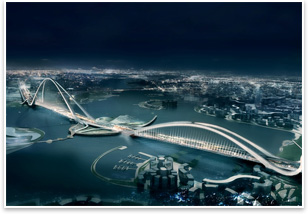 How do you . . . find inspiration for a bridge design? How do you . . . find inspiration for a bridge design?
Summary: FXFowle International LLC, based in New York City and Dubai, has won a design competiton to build a multi-transportation and pedestrian bridge in Dubai, United Arab Emirates. The bridge, dubbed the Sixth Crossing at Dubai Creek, will become the world’s widest and tallest arch bridge but will actually be two asymmetrical suspended arches linking to an artificial island in Dubai Creek. The design is expected to become final in approximately one year, with construction expected to take four and one-half years.
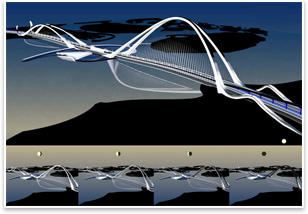 The Sixth Crossing at Dubai Creek, receives its name quite literally as the sixth crossing of Dubai Creek, joining four bridges and one tunnel. Two suspended arch spans will compose the bridge. The western arch bridge will span 2,200 feet, rising 675 feet, while the eastern bridge will span 1,840 feet, rising 290 feet. Its high arch spans will provide for future water traffic. Taken together, the bridge will become the largest and tallest spanning arch bridge in the world. The Sixth Crossing at Dubai Creek, receives its name quite literally as the sixth crossing of Dubai Creek, joining four bridges and one tunnel. Two suspended arch spans will compose the bridge. The western arch bridge will span 2,200 feet, rising 675 feet, while the eastern bridge will span 1,840 feet, rising 290 feet. Its high arch spans will provide for future water traffic. Taken together, the bridge will become the largest and tallest spanning arch bridge in the world.
The bridge will have six traffic lines in each direction, two light rail lines, and pedestrian and bicycle paths underneath the bridge deck to protect walkers and bikers from the Dubai sun. The two arches will land on a proposed artificial island in front of—and linking to—the Dubai Opera House, sited on a separate artificial island.
“We are honored to have been selected,” says Sudhir Jambhekar, FAIA, LEED-AP, principal-in-charge and senior partner at FXFowle International. ”Hard work paid off. We feel very good about it and think our design will contribute very well to Dubai. We hope it will become a signature piece.”
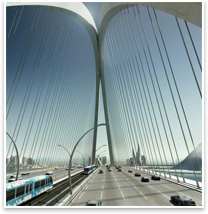 Looking for inspiration Looking for inspiration
Jambhekar says he and his firm didn’t set out to design the world’s longest and tallest arch bridge. In addition to providing an efficient transportation link, the arch design was inspired by the future Dubai Opera House, Arabian calligraphy, regional and cultural imagery, and climate. “A bridge is a unique typology because it offers you the opportunity to make a great urban gesture, and it can be very sculptural in many ways,” he says. “An urban gesture has to work on many levels because it has to connect community. The sculptural aspect, which is the form, is the quest. What can we do so the design becomes unique to its place?”
Jambhekar recalls his first reaction was to do a big, tall suspension bridge. “Then we went looking for inspiration,” he says.
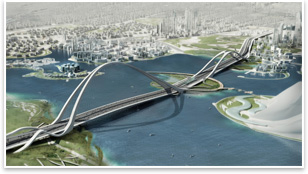 The Opera House The Opera House
It was important to respect the new Dubai Opera House, Jambhekar points out. He and his firm took information and images related to the future Dubai Opera House, using its proposed parabolic shape to help complement the form of the Sixth Crossing. Instead of a single span overwhelming the Opera House island, two arch spans could land on the island to flank and blend with the Opera House. The midpoint landing would also provide a transportation hub to the Opera House island.
Regional, cultural inspirations
The fluidity of the Arabian calligraphy provided design inspiration for a double arch design, Jambhekar says. Next came the imagery of water and sand dunes. “Sand dunes in that part of the world are natural reference points,” he notes. “Water is also a tremendous nautical reference because the Dubai Port, one of the oldest in that part of the world, the Arabian Gulf, and the Dubai Creek.” The lunar cycle also provided design inspiration. “The Islamic world follows the lunar calendar,” Jambhekar adds. “In the Koran, there are great stories about calendars, half moons, and crescent moons. It became obvious that the lunar calendar could be celebrated, and the lighting can be expressed in the manner that expresses that calendar.”
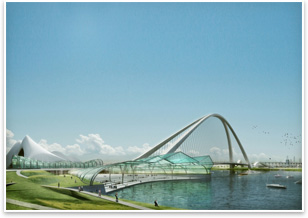 Dubai’s hot sun also came into play, as pedestrian walkways and bike paths will be tucked underneath the roadway for shade. The Sixth Crossing will also link to a wildlife sanctuary at the end of the Creek. Dubai’s hot sun also came into play, as pedestrian walkways and bike paths will be tucked underneath the roadway for shade. The Sixth Crossing will also link to a wildlife sanctuary at the end of the Creek.
“At the end of the day an arch suspension was the solution,” Jambhekar says. “The two bridges are asymmetrical, but together create a fluid form.” |






